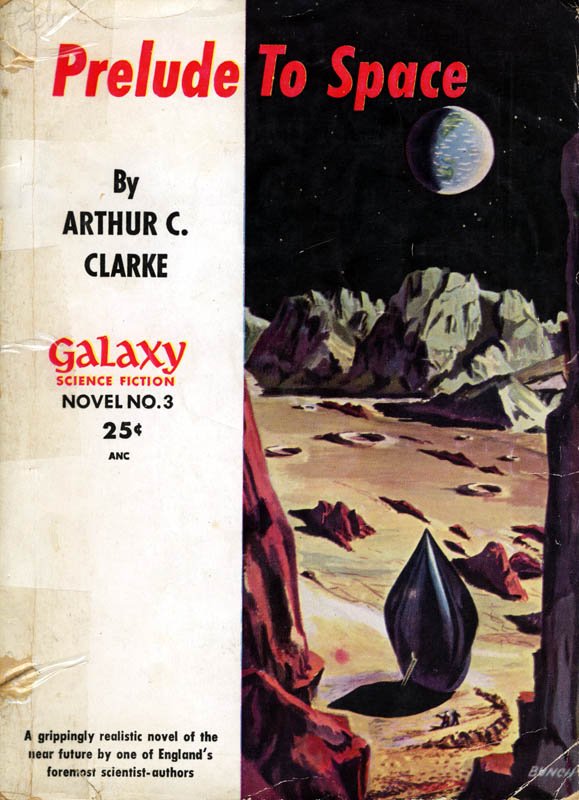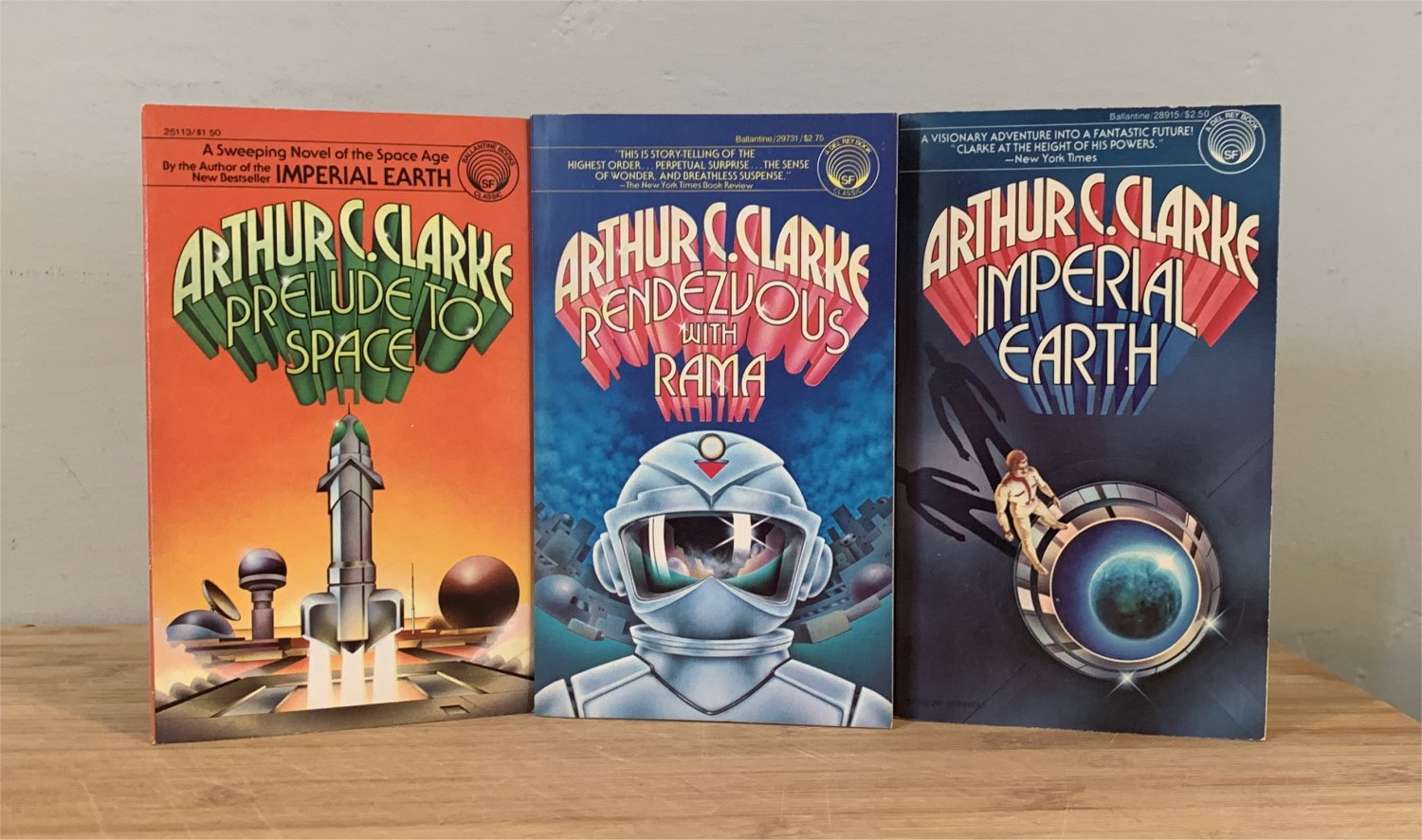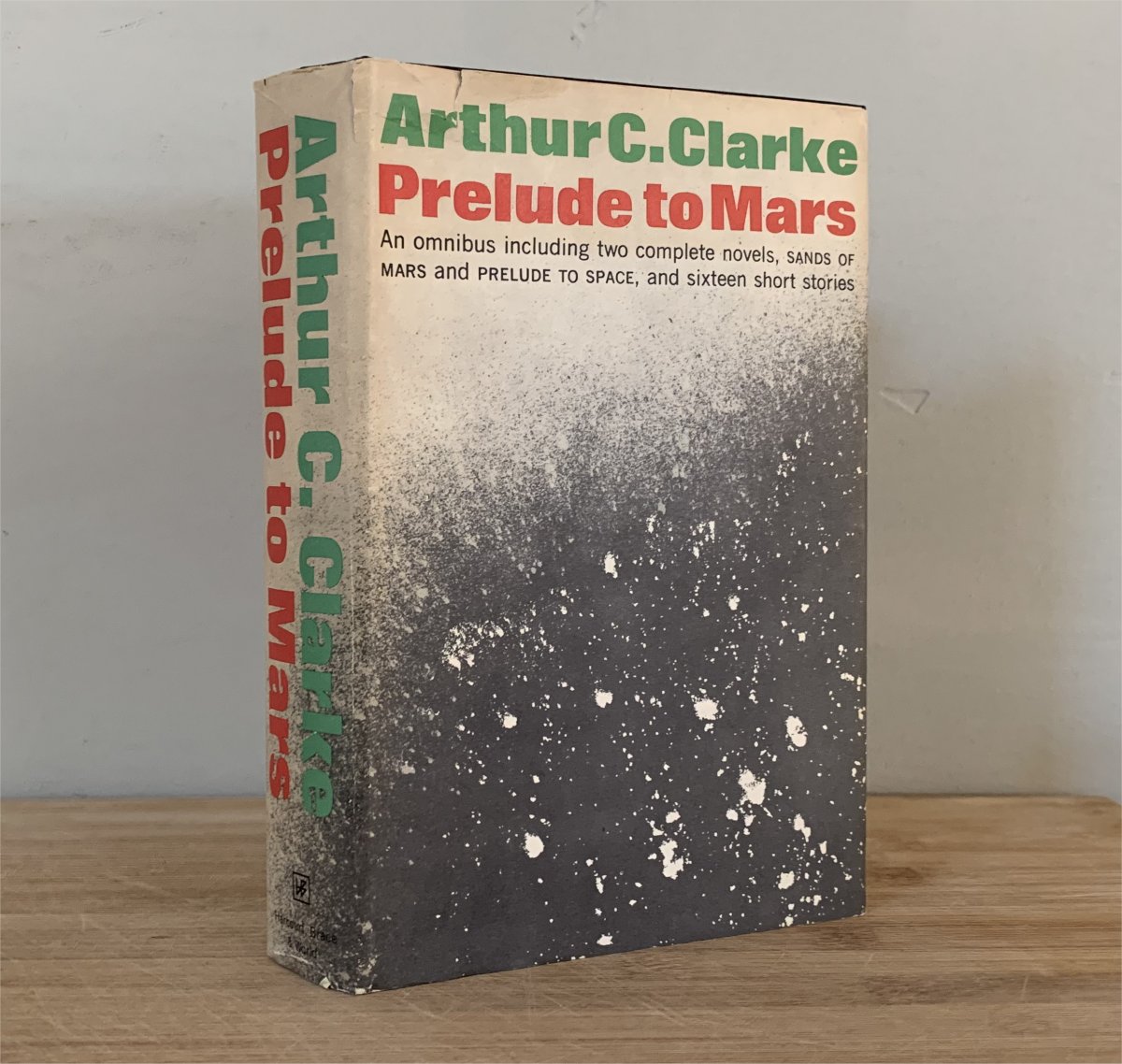We Have Launch: Arthur C. Clarke’s Prelude to Space
Prelude to Space by Arthur C. Clarke; First Edition: World Editions, Inc. (Galaxy Science Fiction Novel #3), 1951
Cover art by Bunch (click to enlarge)
Prelude to Space
by Arthur C. Clarke
World Editions, Inc. (Galaxy Science Fiction Novel #3) (160 pages, $0.25 in magazine digest format, 1951)
Having in my two previous columns here covered Isaac Asimov’s first proper novel (Pebble in the Sky) and Robert A. Heinlein’s first-written novel (For Us, the Living), it’s appropriate now to revisit Arthur C. Clarke’s first novel, Prelude to Space. (Asimov, Heinlein, and Clarke were regarded as the “Big Three” science fiction writers for several decades beginning in the 1950s.) This is a novel about the launch of the first spaceship to go to the moon. Clarke had a background in radar and aeronautics — he famously anticipated the use of geosynchronous satellites for communications — and so one might expect a more truly scientifically authoritative novel compared to those from Asimov (whose background was only in biochemistry) and Heinlein (military service and politics). Indeed, Clarke’s novel is a better guess about how a launch to the moon would work than were those of other writers of the time, who clung to the vision of heroic lone inventors and single enormous rockets that would take off and return intact. Still, some of Clarke’s guesses were misses.
The novel was published in 1951 as a “Galaxy Science Fiction Novel” in magazine digest format, (as were some 45 other titles over the decade of the 1950s). Its first book publications were in 1953 from Sidgwick & Jackson in the UK, and in 1954 from Gnome Press in the US, and shortly thereafter if not simultaneously in paperback from Ballantine Books in the US, who kept the book in print for 40 years. (Isfdb doesn’t show a print edition since Ballantine’s last, 1993, edition.)
Critics have occasionally complained about Clarke’s stilted prose — SFE even makes a point of saying this and his second novel “suffer from the rather wooden prose which Clarke later fashioned into a more flexible instrument, though he was never able to escape an occasional stiffness in his writing.”
I’ve always perceived his prose quite differently, at its best eloquent and evocative, with appeals to the scope of time and space as a context for human society, how moves like this first trip into space are evolutionary events. At worst, his prose can be portentous, too many things imbued with cosmic significant, and a little portentousness goes a long way, but Clarke’s is not the stiff prose of engineers whose writing is barely grammatical (as I experienced in my own engineering career). At his best, Clarke evokes the awe and mystery of the vast cosmos, and humanity’s tiny place in it, in ways that anticipated Carl Sagan’s writing.
Gist
In 1978, the first spaceship to travel to the Moon and back, headquartered in the UK and built in Australia, is readied, with a crew of three. There are political issues to deal with and interference from a religious zealot, but the launch goes off as planned, launching a new era in humanity’s evolution.
Take
It’s hard to imagine how much better a novel about the first launch to moon could have been, in 1951. Some of Clarke’s speculations — especially that the ship would be launched from 5-mile long track in the Australian desert, rather than on a rocket — miss the mark, but his realization that the configuration of the ship would not be a enormous single-stage rocket, but rather staged, and not financed by the private sector, but by government, were prescient. Clarke provides an authenticity to the proceedings, no doubt gleaned from his own service experience, that no one else does. And Clarke pauses for speculations and philosophy and political insights.
1976, 1980, and 1981 Ballantine editions of three Clarke novels, with cover art by Stanislaw Fernandes:
Prelude to Space, Rendezvous with Rama, and Imperial; the art for the first is suggestively symbolic, but inaccurate. (Click to enlarge.)
Description with Quotes and Comments
The book is divided into three parts, each of which begins with a multi-page italicized scene-setting. Page references are to the Ballantine edition shown above.
Part One
Begins with a description of the first spaceship, Prometheus, build in the Australian desert, and its Alpha and Beta parts and how they will interact on the voyage, given the realization that the trip to the moon and back couldn’t be done in one machine.
Let’s start right away with some consideration of Clarke’s prose. The opening paragraph:
For five miles straight as an arrow, the gleaming metal track lay along the face of the desert. It pointed to the northwest across the dead heart of the continent and to the ocean beyond. Over this land, once the home the aborigines, many strange shapes had risen, roaring, in the last generation. The greatest and strangest of them all lay at the head of the launching track which it was to hurtle into the sky.
Wooden? Stiff? I think it rather eloquent. Yet this section ends with some mild portentousness:
In a few weeks, if all went well, she would carry the hopes and fears of humanity into the lonely deeps beyond the sky.
- The narrative follows Dirk Alexson, an historian sent by his university (in the US apparently, via a flying wing) to London to cover the first lunar expedition, from an historian’s perspective (to explain things his contemporaries would take for granted). He’s taken the mission’s headquarters, a building called INTERPLANETARY, given an office, and reads books and reports about the history of space flight, beginning with Oberth’s calculations of how it would be done. He reviews history from 1959, when the Army sent “Orphan Annie” to deliver a payload to the moon.
- There’s discussion of the motives for interplanetary missions, page 18 middle:
There were a lot of people in this country who didn’t intend to wait that long. They believed that the crossing of space was as essential for progress as the discovery of the New World had been four hundred years before. It would open up new frontiers and give the human race a goal so challenging that it would overshadow national differences and put the tribal conflicts of the early twentieth century in their true perspective. Energies that might have gone into wars would be fully employed in the colonization of the planets—which could certainly keep us busy for a good many centuries. That was the theory, at any rate.
- Other motives include the danger from atomic bombs, and for broadcasting around the globe. But mostly, to find out what the planets are really like.
- Meanwhile, five candidate astronauts are living together in a house, secretly. Only three will be chosen to go. (Actually, the word astronaut is not used, just flight crew, or pilot.)
- We meet an Irish Tory politician whose constituents question the value of space flight; why go the moon? (Clarke anticipates a lot of social responses to the space program.) The response (page 45):
Civilization could never stand still. Over the very ground on which he was walking, the mammoths had once come trampling through the rushes at the river’s edge. They, and not the ape-men watching from their caves, had been the masters of this land. But the day of the ape had dawned at last: the forests and swamps had given way before the might of his machines. Dirk knew now that the story was merely beginning. Even at this moment, on far worlds beneath strange suns, Time and the Gods were preparing for Man the sites of cities yet to be.
- The section ends with a plot snag: one of the candidate astronauts is about to have a son, who would be born during the flight. Does this rule him out?
Part Two
This begins with another italicized section describing, gently and precisely, how the Beta vehicle will deliver a fuel container of methane into orbit and then descend back to Earth (for reuse). Clarke’s style in such sections was unchanged 17 years later in his novel version of 2001: A Space Odyssey.
- Details about the mission become public. Alexson meets atomic engineer Maxton, who explains the atomic drive, which uses air in the atmosphere (a ramjet) and methane in space. Alexson finds his own attitudes shifting; the idea of long distances and the vastness of space no longer put him off. A press conference with the astronauts involve sometimes silly questions. Page 76:
“What do you expect to find on the Moon?”
“Lots of lava, and very little else.”
“Do you expect to find any life on the Moon”
“Very likely. As soon as we land, I expect there’s be a knock on the door and a voice will say, ‘Would you mind answering a few questions for the Selenites’ Weekly?’”
- There’s a chat with a Sir Robert about the motives for space travel: both material and spiritual, or perhaps “intellectual”, the spirit of play.
- As the launch date approaches, most the of staff readies to go to Australia.
- The potential lead astronaut, Hassell, who’s about to have a child, wanders through a museum, hoping not to be recognized. But he is, by two boys, and a man reading a newspaper. He meets up with Alexson, and at a pub, are recognized and given a fine bottle of wine.
Part Three
The italicized intro is a longer one, about attitudes toward space travel: the strategic ones (military bases and control of space), and the theological opposition, worth quoting:
A second and perhaps more important body of opinion, while admitting that interplanetary travel was possible, opposed it on mystical or religious grounds. The “theological opposition,” as it was usually termed, believed that man would be disobeying some divine edict if he ventured away from his world. In the phrase of Interplanetary’s earliest and most brilliant critic, the Oxford don C. S. Lewis, astronomical distances were “God’s quarantine regulations.” If man overcame then, he would be guilty of something not far removed from blasphemy.
And the idea of escaping the eventual fate of the Earth, and whether humanity would merely bring its misery to possibly more advanced worlds, with an analogy of “a fleet of savage war-canoes drawing slowly into New York harbor.”
And discussing the cranks, the flat earthers [even in 1951!], the psychics who already know all about what the planets are like (these are usually little old ladies). But ending with a manifesto from the mission’s planners: “”We will take no frontiers into space.”
- The principal characters arrive in Australia (via a layover in Iran), to stay at a “Lunar City” of army huts.
- He’s given a tour of the ship, and told about the radioactive risk. The Alpha component is compactly designed for three travelers in zero-G.
- There are some plot machinations about which three of the potential astronauts will go, decided by a literal drawing, though a fixed drawing.
- There’s speculation about life and the future, whether humans will reach the stars. No, they decide, because FTL and a fourth dimension are unlikely. And yet, earlier people dismissed relativity…
- Then a lecture about how, once humans reach the moon, it will be used as a base for exploring the planets, by the end of the century.
- And then there’s the incident with the religious zealot, one Jefferson Wilkes, an accountant in the US who we’re told has never thought deeply about much of anything, but who’s developed a firm conviction that the launch into space must be stopped, at risk of some kind of metaphysical doom. [[ This anticipates the many people convinced of various conspiracy theories, like Pizzagate, who are persuaded via malicious YouTube videos. ]] So he leaves his job and flies to Australia, and finds it easy enough to wander around Luna City. He plans to empty the oxygen cylinders. But, we’re advised on page 155.6, “Many years ago the planning staff had foreseen the possibility of sabotage by religious fanatics…” And so when Wilkes wanders out toward the ship, alarms go off, a guard named Achmet Singh warns him away over loudspeaker; Wilkes flees in panic — and climbs into the “tunnel” of the aft engines… where he collapses, is rescued by the metallic claw, and lays dying of radioactive poisoning.
- News of the event spreads the next morning, but doesn’t affect launch plans. Dirk gets a look at the moon through a telescope, and hears about the two types of astronomers, neither of whom actually look through telescopes, p162: One type “spends its working hours taking photos of objects so far away that they probably don’t exist anymore” and have no interest in the solar system; the second type “inhabit offices full of calculating machines and lady computers” to “produce reams of mathematics about the — probably non-existent — objects photographed by their colleagues…”
- Launch day arrives. Sir Robert reads a manifesto declaring all planets free of sovereign claims. There’s a countdown (10 minutes… 5 minutes… 1 minute — but no counting down the last 10 seconds) and the “launch” begins as the Prometheus glides down the long track, in perfect silence, at the end lifting into the sky…
Epilogue
- Years later, Dirk Alexson is in his office — on the Moon. An unexpected benefit of colonizing the Moon was to serve it as a refuge for people with heart conditions — like Alexson — to live longer in light gravity than they would have on Earth. There are some 5000 such exiles here. Now Alexson handles a piece of Martian sandstone sent to him by Victor Hassell — who we understand led the first expedition to Mars — and ponders the end of the century, and a new era.
- Here is some more Clarkeian perspective in the final lines:
Out of the fears and miseries of the Second Dark Age, drawing free — oh, might it be forever! — from the shadows of Belsen and Hiroshima, the world was moving toward its most splendid sunrise. After five hundred years, the Renaissance had come again. The dawn that would burst above the Apennines at the end of the long lunar night would be no more brilliant than the age that had now been born.
SF Book Club edition of 1965 Harcourt, Brace & World omnibus Prelude to Mars,
containing the novels Prelude to Space and The Sands of Mars, and sixteen short stories;
jacket design Lawrence Ratzkin. (Click to enlarge.)
Comments
- Isaac Asimov also anticipated religious opposition to space travel (in “Trends”) and to scientists (in “Nightfall”), in ways that fortunately never came to pass. (Well, except for the antipathy towards experts by the current administration and its supporters, but that’s not quite the same.) Heinlein, in “The Man Who Sold the Moon,” wasn’t concerned about it.
- Heinlein’s story was more prophetic than Clarke’s in one sense: D.D. Harriman initially dismisses the idea of a catapult, and instead builds a hydrogen/oxygen rocket with multiple “steps” (stages). But the limited payload of that ship makes Harriman change his mind, and the story ends with a larger craft, carrying seven, launched by catapult. Heinlein’s story was published in February 1950, Clarke’s sometime in 1951, so Clarke presumably read the earlier story and considered his own premises in light of it.
- Still, Clarke’s story was more prophetic than Heinlein’s a crucial sense: it’s about a mission to space not due to the heroic effort of a single entrepreneur (or an Uncle and three high school boys as in in Rocket Ship Galileo) but rather due to a coordinated effort supported by one nation’s government and deployed internationally. As it actually happened, 25 years later.
- The epilogue anticipates a later Clarke short story, “Death and the Senator” (1961), that keyed off the supposed health benefits of space exploration, again to extend the lives of people with heart conditions.
This first novel by Arthur C. Clarke embodies the two principal themes that informed his later work: the precise technical engineering details of how spaceflight would work, and the evocation of humanity’s place in the universe and its potential to explore and understand it.
Mark R. Kelly’s last review for us was Robert A. Heinlein’s For Us, the Living. Mark wrote short fiction reviews for Locus Magazine from 1987 to 2001, and is the founder of the Locus Online website, for which he won a Hugo Award in 2002. He established the Science Fiction Awards Database at sfadb.com. He is a retired aerospace software engineer who lived for decades in Southern California before moving to the Bay Area in 2015. Find more of his thoughts at Views from Crestmont Drive, which has this index of Black Gate reviews posted so far.



I have that SF Bookclub edition you show. I reread this a couple of years ago, and was surprised at how well it held up. though dated, it all made perfect sense and I enjoyed it. Thanks very much for the review!
For some reason I have never reread that book after encountering it probably at the age of 12 or so, when Clarke was one of my gateways to adult SF. I really don’t remember it at all!